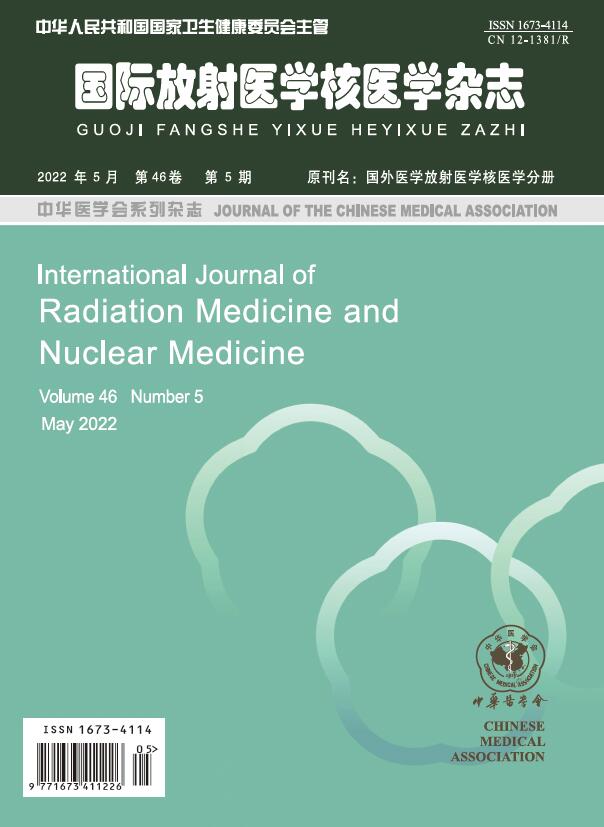-
肿瘤治疗技术的进步使患者生存期延长,但伴随的不良反应也增加了其病死率[1]。其中肿瘤治疗相关心功能不全(cancer therapy-related cardiac dysfunction,CTRCD)是最严重的不良反应,可能会使治疗中断从而影响治疗效果;降低患者的生存质量甚至导致患者过早死亡[2-3]。蒽环类药物(anthracyclines,ANTs)自20世纪60年代问世以来,因其抗肿瘤作用强、抗肿瘤谱广而闻名,已作为淋巴瘤的一线治疗药物。多数淋巴瘤患者通过规范治疗,生存时间可显著延长,甚至终身治愈[4]。但ANTs造成的不可逆的心脏损伤会影响预后[5]。有研究结果表明,在给予ANTs多年后,超过50%的患者可发生左心室亚临床变化[6]。若能及早发现心肌损伤并予以干预治疗,患者通常恢复良好[7]。目前,CTRCD主要根据左心室射血分数(left ventricular ejection fraction,LVEF)进行诊断[3, 8-10],但尚无统一的诊断标准。欧洲肿瘤医学会提出,当超声心动图测量的LVEF>50%,但与治疗前相比LVEF下降>15%时,仍可诊断为CTRCD[8]。但是有研究结果表明,LVEF并不是一个灵敏指标,当心内膜活体组织病理学检查已经观察到心肌损伤时,LVEF并未下降[11]。因此,需要选择更加灵敏准确的技术方法对CTRCD进行早期检测,如超声心动图心肌应变成像、心脏磁共振(cardiac magnetic resonance,CMR)心肌应变成像和心肌组织定量成像以及PET/CT显像。本文就可能有助于早期检测ANTs心脏毒性的影像学新方法进行综述。
-
超声心动图心肌应变成像是通过二维和三维斑点追踪(speckle tracking derived,STE)技术对心肌进行评估,其主要反映心肌力学的改变。左心室心肌应变参数包括整体纵向应变(global longitudinal strain,GLS)、周向应变和径向应变,其中GLS是肿瘤治疗期间评估心脏毒性研究最广泛的参数[3]。多项国际共识认为,对于CTRCD左心室收缩功能障碍的评估,GLS较 LVEF更灵敏[3, 8-10]。美国超声协会和欧洲心血管影像协会联合发布的共识中提出,当GLS较治疗前下降>15%时,可诊断为亚临床CTRCD[9]。一项纳入1 783例恶性肿瘤患者的荟萃分析结果显示,与基线相比,ANTs(部分患者联合曲妥珠单抗)化疗期间GLS受损越严重,患CTRCD的风险越高[12]。
目前,GLS并未在临床中得到广泛应用。其原因为通过二维STE评估心肌应变存在一些固有的局限性,如斑点脱离平面运动的脱靶追踪、长时间多点图像采集等,这导致检查时间过长、图像质量参差不齐[13]。而三维STE的技术克服了二维STE的缺点,可同时获得整体及局部的心肌应变参数[14]。但是三维STE仪器供应商之间的差异和斑点追踪软件的频繁升级导致无法获得统一的参考值且无法进行多次对比,从而导致三维STE难以被临床广泛接受[13, 15]。尽管如此,超声心动图心肌应变成像仍是多项国际共识公认的早期检测CTRCD的方法。
-
CMR是评估心肌质量、心室容积及心脏收缩和舒张功能的“金标准”[16]。Tahir等[17]的研究结果表明,CMR的多个参数(如心肌应变参数、心肌组织定量参数等)是检测化疗患者亚临床左心室机械变化及间质纤维化的新方法。
-
CMR心肌应变技术多种多样,其中以心脏磁共振特征追踪(cardiac magnetic resonance feature tracking,CMR-FT)技术为代表。CMR-FT可以通过常规CMR电影成像评估心肌应变,无需进行额外扫描[18]。CMR-FT与STE相似,都可以评价心肌力学的改变,但CMR-FT结合了心内膜和心外膜的边界追踪、心肌组织内体素运动的模式追踪,减少了对观察者的依赖性[19]。Wang等[20]通过CMR-FT技术对ANTs心脏毒性比格犬模型进行研究,结果表明,GLS可能是早期检测ANTs心肌损伤的标志物。Harries等[21]的研究结果表明,与健康对照组相比,接受ANTs治疗且 LVEF 正常的肿瘤幸存者的心肌GLS明显受损。但是该研究观察到的变化是亚临床的,未对受试者是否发生CTRCD进行随访,因此,其临床意义需要进一步评估。
-
ANTs心肌病早期以心肌水肿、炎症和空泡化为特征表现,后期以弥漫性心肌纤维化为主要表现[22]。CMR具有独特的无创性评估心肌组织的能力。平扫T1值和T2值是通过纵向弛豫时间定量成像(T1 mapping)和横向弛豫时间定量成像(T2 mapping)获得的心肌组织定量参数,可以反映心肌细胞微观结构的变化,而且通过T1 mapping还可获得细胞外容积 (extracellular volume,ECV)值,即细胞外间质容积占整个心肌容积的百分比[23]。平扫T1值和ECV值可以评估心肌弥漫性纤维化,平扫 T2值可以评估心肌细胞水肿[23]。Galán-Arriola等[22]的动物实验研究结果表明,平扫 T2值升高是大白猪ANTs心脏毒性的早期表现。研究者发现,给予大白猪阿霉素6周后平扫 T2值显著升高,这与心肌细胞水肿相关,而且早于LVEF的降低;此外,当检测到平扫 T2值升高后停止化疗可以阻止左心室功能障碍的进一步发展。Park等[24]发现,阿霉素治疗组大鼠在第6周时出现平扫T1值、平扫T2值和ECV明显升高,而LVEF在第12周时才显著下降。Tahir等[17]的前瞻性研究结果表明,39例乳腺癌患者在表阿霉素化疗结束时平扫 T1值、平扫T2值升高,而且平扫T1值与LVEF≤60%联合使用可以对后续发生的CTRCD进行早期预测,灵敏度和特异度均达到75%以上。这些研究结果均表明,CMR心肌组织定量成像在早期检测ANTs心脏毒性方面具有临床应用潜力。
CMR的T1 mapping和T2 mapping是一种有价值的非侵入性方法,可反映ANTs心脏毒性的亚临床组织病理学变化,但这些发现对接受ANTs治疗的肿瘤幸存者的临床和预后价值仍需被充分证实。
-
ANTs心脏毒性是多因素相互作用的结果,主要机制是氧化应激和能量代谢损伤,可表现为心肌线粒体的损伤和心肌能量底物的改变,即脂肪酸代谢减少、葡萄糖代谢增加[25]。18F-FDG PET/CT代谢显像可评估各组织脏器的葡萄糖代谢活性,在临床应用中具有独特的优势。18F-FDG PET/CT肿瘤显像时,患者需要禁食4~6 h以抑制心肌对葡萄糖的生理性摄取,从而通过18F-FDG摄取情况评估心脏是否出现异常糖代谢增高。因此,18F-FDG PET/CT在评估患者病情及疗效的同时也能识别心脏能量代谢的损伤。Bauckneht等[26]对69例霍奇金淋巴瘤患者连续行4次18F-FDG PET/CT显像(化疗前、化疗中、化疗后及随访期)中左心室的SUV进行了分析,结果表明,随着阿霉素剂量的增加,左心室心肌18F-FDG摄取会增高;同时他们还进行了动物实验,同样发现阿霉素化疗后小鼠左心室心肌18F-FDG摄取显著增高,并指出这种代谢效应的剂量依赖性十分明显,而且实验具有可重复性。Seiffert等[27]的研究结果也表明,在阿霉素化疗前、化疗中及化疗后,淋巴瘤患者左心室心肌18F-FDG摄取总体呈上升趋势。这2项研究结果均表明,左心室18F-FDG的摄取随着ANTs剂量的增加而增高,因此,左心室18F-FDG摄取增高可能是ANTs心脏毒性的早期迹象,而且与ANTs心脏毒性的剂量依赖性有良好的一致性。Sarocchi等[28]发现,阿霉素化疗会导致霍奇金淋巴瘤患者左心室心肌18F-FDG摄取增高并与LVEF下降有关。这进一步证明左心室心肌18F-FDG摄取增高与ANTs心脏毒性有关。卫毛毛等[29]发现,18F-FDG PET/CT能早期诊断ANTs的心脏毒性,且以治疗后心脏与本底的SUVmax比值=7.0为阈值时,特异度可达到80%。但SUV受禁食时间、血糖浓度、显像时间和显像设备等多种因素的影响,而且应用18F-FDG PET/CT评价ANTs心脏毒性需要对比分析,因此SUV在临床应用中存在一定的局限性[30]。Bauckneht等[31]通过评分法分析36例霍奇金淋巴瘤患者的18F-FDG PET/CT显像,结果显示,相对于SUV的评价方法,评分法或许能改善患者和显像设备间的可变性,使18F-FDG PET/CT显像成为多中心环境下预测阿霉素心脏毒性的工具。评分法可能在18F-FDG PET/CT评价ANTs心脏毒性中更具临床实用性,但相关研究较少,而且缺乏统一的评分标准。
此外,Borde等[32]回顾性分析18例淋巴瘤患者阿霉素化疗前后的18F-FDG PET/CT显像,结果显示,部分患者化疗后左心室心肌18F-FDG摄取增高,并提出这可能与ANTs心脏毒性的个体易感性有关。Gorla等[33]报道了一例霍奇金淋巴瘤患者(男性,30岁)接受低剂量阿霉素(320 mg)化疗后左心室心肌18F-FDG摄取较化疗前显著增高且随后被诊断为急性心肌损伤的病例,而2次检查在饮食、禁食时间(6 h)和血糖水平(分别为73 mg/dl和82 mg/dl)等方面的差异无统计学意义,因此,他们认为阿霉素化疗后在18F-FDG PET/CT显像中,左心室心肌18F-FDG摄取显著增高可能是早期发现急性心肌损伤的影像学表现。该病例报道排除了影响左心室心肌18F-FDG摄取的混杂因素,证明了左心室心肌18F-FDG摄取增高与ANTs心脏毒性相关,并验证了ANTs心脏毒性显著的个体差异性。
临床中常用的评估ANTs心脏毒性的方法都需要额外的、甚至是高昂的费用。18F-FDG PET/CT作为肿瘤患者(尤其是淋巴瘤患者)的常用检查方法,不仅能监测病情变化、评估治疗效果,也有可能在不产生额外的检查费用及辐射的情况下早期评价ANTs的心脏毒性。但由于心肌代谢的复杂性[34],心肌18F-FDG摄取的变异较大,即使在禁食4~6 h的情况下,心肌18F-FDG摄取仍然是可变的、不一致的,这往往给临床诊断带来困难。有研究结果表明,延长禁食时间及低碳水化合物、高脂、高蛋白饮食等可以更好地抑制心肌18F-FDG的生理性摄取[35],但其临床实施的可行性仍需评估。此外,临床中存在多重混杂因素(如患者合并心血管疾病、糖尿病等),使CTRCD对心肌代谢的影响并不是十分明确。
目前关于18F-FDG PET/CT评价ANTs心脏毒性的研究多为回顾性且数量较少,而且患者检查前并没有进行特殊准备来进一步抑制心肌18F-FDG的生理性摄取。今后仍需大规模的前瞻性研究进一步证明其临床意义。
-
线粒体是ANTs心脏毒性的主要靶点[36-37],约占心肌细胞体积的35%,并且是产生活性氧簇(reactive oxygen species,ROS)的主要来源[36]。新型线粒体和ROS的PET分子特异性探针可以在亚细胞水平检测心脏损伤,从而可对ANTs的心脏毒性进行早期无创性评估[38]。18F-Mitophos(一种对线粒体膜电位敏感的亲脂性阳离子)和68Ga-Galmydar(一种疏水性镓离子络合物)是常用的线粒体靶向示踪剂,18F-6-(4-((1-(2-fluoroethyl)-1H-1,2,3-triazol-4-yl)methoxy)phenyl)-5-methyl-5,6-dihydrophenanthridine-3,8-diamine (DHMT)是ROS靶向示踪剂[38- 39]。Sivapackiam等[40]的动物实验结果显示,阿霉素治疗组大鼠心脏68Ga-Galmydar的摄取量(SUV=0.92)较对照组(SUV=1.76)低。McCluskey等[41]的研究结果也表明,阿霉素化疗组大鼠心脏18F-Mitophos的摄取量低于对照组,而且当阿霉素剂量增加时,这一现象更加明显。Boutagy等[39]的研究结果表明,在给予阿霉素化疗的大鼠的LVEF下降之前,18F-DHMT PET/CT显像可检测到心脏ROS生成明显增加。同时有研究结果表明,18F-DHMT PET/CT显像也能对大型动物模型(比格犬)心肌ROS的产生进行绝对定量分析[42]。这些实验研究结果均表明,PET/CT分子显像可在早期对ANTs心脏毒性的代谢变化进行无创性评估。诱导心肌细胞凋亡是ANTs心脏毒性的机制之一[37]。PET凋亡分子显像可在活体内观察细胞凋亡,是一种有效的、无创性检测方法。Su等[43]在ANTs心脏毒性小鼠模型中发现小鼠心肌细胞凋亡增加,18F-caspase18摄取增高。石琴等[44]的动物研究结果表明,与阿霉素化疗前及对照组相比,小鼠心脏18F-2-(5-氟-戊基)-2-甲基丙二酸(18F-ML-10)的摄取量在给药后的第2(4 mg/kg)、9(8 mg/kg)和16 天(12 mg/kg)持续增高,而CMR检测获得的LVEF在第16天明显降低。前述研究结果初步表明,PET凋亡分子显像可用于早期评估ANTs的心脏毒性。
在动物实验中,PET分子特异性探针有助于早期检测ANTs的心脏毒性,而且与18F-FDG相比,干扰因素较少,具有更大的临床转化优势。但是这需要在临床受试者的前瞻性研究中进行检验,以确认其在人体中的显像效果。
-
CTRCD是影响肿瘤患者长期生存的重要因素之一,尤其是ANTs的心脏毒性,早期发现有助于更好地治疗与恢复。超声心动图心肌应变、CMR心肌应变及心肌组织定量成像、PET/CT等先进成像方法或许能改变以往依靠LVEF来确定患者发生ANTs心脏毒性的风险,并可能在不可逆损伤发生之前对ANTs的心脏毒性进行早期检测,从而改善肿瘤幸存者的临床结局。但是这些影像学新方法的临床和预后评估效用仍需进一步充分证实,而且在临床工作中的实际应用仍面临着挑战。
利益冲突 所有作者声明无利益冲突
作者贡献声明 王璐霞负责命题的提出、文献的查阅、综述的撰写;郝新忠、王若楠负责综述的审阅;李思进负责综述的修订
Advances in imaging research on the early detection of anthracycline cardiotoxicity
- Received Date: 2022-01-09
- Available Online: 2022-05-25
Abstract: With the advancement of treating methods, the survival rate and survival time of tumor patients have improved significantly, but the cancer therapeutics-related cardiac dysfunction seriously threatens the health of tumor survivors, among which the cardiotoxicity caused by anthracyclines (ANTs) is extremely common and can lead to irreversible heart damage. Early detection and timely treatment of cardiotoxicity caused by ANTs are essential for the recovery of cardiac function, so early detection of cardiotoxicity is of great clinical importance. The author focuses on new imaging methods that may help to detect the cardiotoxicity caused by ANTs early, including myocardial strain imaging by echocardiography, myocardial strain imaging and quantification imaging of myocardial tissue by cardiac magnetic resonance and PET/CT imaging, in order to provide valuable information for early clinical detection of cardiotoxicity caused by ANTs.








 DownLoad:
DownLoad: